#maim your characters
This post is an excerpt from Maim Your Characters: How Injuries Work in Fiction. It’s one of nine injury analyses that appear in the book, but this one is near and dear to my heart, especially because you all helped pick it. I asked a couple of months ago for injuries to analyze in fiction, and this one was suggested above all others. I hope it doesn’t disappoint!

(Image courtesy of Dreamworks)
Format:Feature Film (animated)
Genre: Action-Adventure / Kids
ealism: Fantasy (high fantasy)
It’s funny. When I put out a call to my readers asking what injuries I should take a look at for this book, I got this kid’s movie as an overwhelmingly popular arc to take a look at. It’s a great representation of disability!
It’s just that everyone suggested specifically the back half of the movie, where a human gets injured.
But I say let’s start from the front and look at both of the arcs in this movie, shall we?
I think everyone forgot the first injury because it happened to a dragon.
How To Train Your Dragon is a Dreamworks movie about a Viking named Hiccup, a chief’s son who’s very… “un-Viking.” As in, he doesn’t want to kill dragons.
Dragons are initially presented as “pests,” but it turns out they’re more than that, they’re a menace: the town of Brunk gets raided, set on fire, all the time.
So here’s an interesting start: the beginning of the movie finds Hiccup working for a disabled blacksmith, who has interchangeable prostheses for his left hand and a peg leg for his right leg. His hand can become anything: a hammer, tongs, even a saw or a battle-axe. Yet his prosthetic leg is just that: a leg, something for him to stand on.
As the blacksmith’s protégé, Hiccup is shown to be a very handy inventor. He makes a mean catapult, and the opening of the movie has him trying to take out a special kind of dragon called a Night Fury. Scary!
To the excitement of all, Hiccup shoots one down! His homemade catapult launches a set of stone balls on a cord, which brings down a Night Fury — a feat no one’s ever accomplished before.
Of course, no one sees him do it, so no one believes him.
But when he goes over to check on the dragon he shot down, it turns out the Night Fury isn’t so tough after all. The beast is tied up in the cords from the weapon Hiccup launched.
In a moment Blake Snyder’s kickass book on storytelling (Save the Cat!) would approve of… Hiccup sets him free!
…and almost gets eaten for his troubles.
But the dragon doesn’tkill him, which is perplexing to Hiccup. After his relief washes away, the ever-curious Hiccup keeps coming back to find out why the dragon hasn’t killed him.
It turns out the dragon — who’s later dubbed Toothless — has an Inciting Injury: one of his tail fins has been ripped off by the accident.
Hiccup has already given him his only Immediate Treatment: he’s cut the ropes that are holding him captive.
But that doesn’t solve Toothless’s flying problems. Toothless is pretty miserable. He has fallen into a ravine he can’t get out of, because his flight trajectories are all messed up by his damaged tail.
The two form a friendship, over fish, over drawings, and Hiccup decides to build him a prosthesis to fix his tail.
This is the first analysis we’ve looked at where the protagonist gives the Definitive Treatment to another character. It’s unconventional, and it’s a risky move on Hiccup’s part, but it gets Toothless back in the air.
Cue the training montage! Hiccup builds a saddle to ride Toothless, and their training forms a Rocky Road to Recovery as they learn to fly together. They train, and Hiccup works through various incarnations of the dragon tail and harness system. They crash, they fly, they crash again, until they get it right.
TheirNew Normal is a great partnership! With Hiccup at the controls of Toothless’s prosthesis, they can fly together. The lessons Toothless teaches Hiccup about the way dragons work make Hiccup a celebrity in his town.
So Toothless’s arc is pretty straightforward…
Toothless’s Injury Arc
Inciting Injury: Tail fin amputated when he’s shot down by Hiccup.
Immediate Treatment: Freed from the projectile, which had tied him down. (A few days later, but hey, he’s a dragon.)
Definitive Treatment: Prosthetic tail fin made by his human handler.
Rocks on the Rocky Road: Toothless and Hiccup almost fall from the sky a few times during the acclimation process, but the wound itself isn’t the issue that needs discussing.
The Big Test: None. By the time we need Toothless to fight, they’ve already reached the last stage.
And the New Normal? A lasting friendship and partnership, where the two can fly — but only together.
This isn’t the only injury arc the movie has in store for us, however. Later in the plot it’s Hiccup’s turn to be maimed.
In the story’s global climax, Toothless and Hiccup are taking out the mother dragon that’s made all the other dragons behave so badly. Their plan has worked — the other dragon’s gone down and exploded!
But up shoots a wall of fire, Toothless’s prosthesis has been burnt away, and Hiccup falls—
And Toothless, ever the faithful dragon, follows him down.
When they hit the ground, there’s a horrifying moment when we think Toothless has been horribly hurt and Hiccup has been consumed by the flames, until Toothless reveals he’s had Hiccup nested inside his wings.
Hiccup has had an Inciting Injury, though we don’t know what it is until the next scene.
He wakes up at home to Toothless’s cheery face snuffling him like a puppy, and we discover when he tries to stand that his injury has been twofold: a head injury (which explains the time lapse) and a lower leg amputation. He’s got a steel prosthetic foot, a Definitive Treatment for an injury we didn’t know he had. (His Immediate Treatment for the burns and concussion was injury prevention: Toothless wrapped him in his wings so he wouldn’t burn to a crisp on the way down.)
Hiccup gets an absurdly short Rocky Road to Recovery as he tries to walk outside and stumbles — but Toothless lets himself be used as a crutch, and helps his friend learn to walk on his new leg.
However, the two get back to their New Normal pretty quickly. Turns out Hiccup’s blacksmith boss — owner of the peg leg and the prosthetic multitool hand — has built a special harness that will allow Hiccup’s new metal foot to lock in to Toothless’s saddle. They can fly again!
(All of this happens in the span of about two minutes of screen time, which is pretty impressive for a fully-told injury arc! However, this arc is abrupt even for a fantasy movie; the character goes from unconscious and unable to walk to flying a dragon in less time than it takes to brew coffee.)
Hiccup’s injury mirrors Toothless’s…
Hiccup’s Injury Arc
Inciting Injury: Falls through some fire. It’s never explained how, exactly, he comes by his leg amputation or his significant head injury which causes him to wake up at home probably weeks later.
Immediate Treatment: Injury prevention, by Toothless swaddling him as the two plummeted together.
Definitive Treatment: While he was unconscious, his blacksmith boss built him a prosthetic leg. His head injury is completely ignored here; it’s implied that he’s been allowed to rest.
Rocky Road to Recovery: Hiccup has some difficulty walking, but it quickly goes away — the magic of filmmaking! He literally stumbles twice.
(To be fair, we’re talking about a movie with Vikings riding dragons and talking with Scottish accents. Realism isn’t exactly their forte.)
The Big Test:None.
New Normal: Hiccup is back to total functional ability. Because his needs have been fully met, he can continue to walk, fly his dragon, and has no apparent significant changes to his life. This can technically be regarded as Total Disability for the foot, since the foot itself was lost, but as he shows no signs of problems walking or performing his activities, it’s almost a meaningless amputation. Functionally, this is No Disability.
What Can We Learn?
Well, first of all, the injury arc doesn’t have to be about the hero to be a meaningful arc for the audience.
The injured character doesn’t even have to be human.
Second of all… notice a theme?
The blacksmith (the only one in the village who truly believes that Hiccup can become a great Viking, by the way) is disabled. His disability is played almost for laughs; he’s got an interchangeable hand (sometimes tongs, sometimes an axe), but his leg prosthesis is just a piece of wood.
Then Toothless gets hurt — by Hiccup’s hand, an emotional element that’s never fully explored. Should Hiccup feel guilty about shooting down what turns out to be a gentle, playful, kind creature?
But Toothless has an injury that’s a parallel to a leg amputation: one of his tail fins is missing, making his usual form of locomotion impossible.
While Toothless is canonically a dragon, he’s modeled very much like a dog in his actions and behaviors: his loyalty, his curiosity, his initial standoffishness that becomes a fierce friendship. Hiccup, seeing this metaphorical dog metaphorically limping, helps.
It’s through his kindness to his companion that Hiccup learns how to save his people — and does just that in the end. Seeing Hiccup’s example of kindness and understanding toward
the once-feared creatures causes a realization in his people: that humans and dragons can coexist peacefully, that each can benefit the other. Hiccup and the Vikings help rid the dragons of an evil overlord, and the dragons stop raiding the village and stealing the sheep.
Hiccup is himself injured near the end as a parallel injury. Thus, the blacksmith, Toothless, and Hiccup all find themselves depending on their prosthetics to move through the world as they once did. The parallelism is phenomenal!
There’s even a moment of kindness repaid: It’s Hiccup who’s taught Toothless to fly again, and it’s Toothless who helps Hiccup walk again.
Now, how can we all learn to incorporate that kind of parallelism into our stories?
It’s also a great example of the Big Battle having consequences — Hiccup’s wound isn’t timed so that his Big Event will coincide with the climax, but so that the climax will be his Inciting Injury.
My one criticism of the film (from an injury arc perspective) is the way in which Hiccup’s arc is shortened.
He remains unconscious for what must have been weeks of sailing home and fitting him for his prosthesis — his smithy mentor has even designed and built a wholly new flight apparatus for Toothless so they can fly again right away.
In terms of time, it takes weeks for a stump to heal enough to accept a prosthetic, and weeks again for the amputee to learn to walk, instead of literally seconds of film time. However, since this is in the denoument of the film, it’s much less irritating than it would be if, say, it had happened before the Big Battle and Hiccup had been on his feet again for the fight.
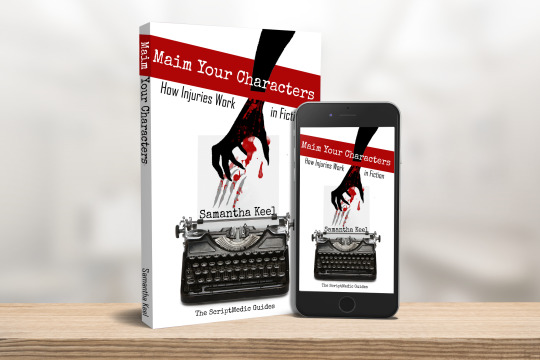
This post is an excerpt from Maim Your Characters, out THIS WEEK from Even Keel Press. If you’d like to read a 100-page sample of the book, [click here]. If you’d like to order a print copy, it’s available [via Amazon.com], and digital copies are available from [a slew of retailers].
It’s not too late to receive the bonus content for Maim Your Characters!
With three extra injury analyses like this and the official ScriptMedic Character Injury Worksheet, plus a copy to keep of the 5 Biggest Mistakes Writers Make Approaching Injuries. Just email a copy of your receipt for the book to AuntScripty{at}gmail{dot}com and I’ll be happy to send your bonus content right along!
xoxo, Aunt Scripty

(This post is an excerpt from Maim Your Characters, which is out today!)
At its core, the Inciting Injury is the catalyst of the injury plot. It’s the moment when the leg snaps, the hammer comes down, or the bullet strikes. It’s the blossom of pain, the initial moment of agony.
There are two significant portions of the Inciting Injury:what happens, and why it happens.
Thewhat is going to determine the way the arc works. Is your character shot in the chest? Did they twist their ankle? Maybe they have a concussion, or a broken arm. You get the idea.
Of course, there’s also the why. The injury might be the effect of some other plot element that is causing your character harm. Did they poke their nose in the wrong badger hole? Are they simply a klutz, or is their injury a consequence of some choice they made earlier on, like going up against a mob boss or invading a foreign nation?
You don’t need to have a great why for a phenomenal injury story to work, as you’ll see in the form of an example: Steven King’s Misery, below.
Injuries tend to happen for one of two reasons. Either they’re completely random (you slip in the tub), or they’re a consequence of some other cause (you ventured into enemy territory and got shot). Which one you use is completely up to you, of course, but I would argue that the best Inciting Injuries are the byproduct of other elements in the plot.
We’re going to go over the exact process of building your own injury plot later on in the book (with an example and the choices we might face along the way), but as we go forward I’m going to give a few examples of the way famous writers have approached each of the elements we need to look at.
We’re also going to take a look at the arc of a fictional character I’ve made up: Billy Badbones, Demon Hunter. Where the other examples are going to get summaries, Billy’s story will be told in shortened versions of the actual scenes.
So let’s look at some examples of Inciting Injuries in fiction.
Example:Misery
Misery is a phenomenal piece of writing from Stephen King. (It was later adapted into a film, starring James Caan and Kathy Bates.) It’s a horror tale: a writer, Paul Sheldon, suffers a terrible car accident and is trapped in the house of his Number One Fan, the disturbed and disturbing Annie Wilkes. Wilkes is a nurse by trade – but an Angel of Death, a nurse who kills her patients. To survive, Paul must write Annie a novel all her own, resurrecting her favorite Sheldon character, Misery.
For Paul Sheldon, the what of his Inciting Injury is a car crash, which gives him a head injury, two broken legs, and a broken pelvis.
Thewhy is a simple accident: Sheldon, who has just finished his latest and greatest novel, goes driving in the snow. The storm picks up, and he crashes his car into a ditch. (Sheldon has just finished his latest and greatest novel). There’s a point to be made about hubris here, but King makes it subtly: it is Paul’s pride in his work that causes him to start driving in a Colorado snowstorm.
One thing that’s unique about Sheldon’s plot is the way in which it’s told. When we first see Sheldon, he’s waking up in a haze of pain and painkillers, at the beginning of his Rocky Road to Recovery. King chose to begin the tale in media res, in the middle of things – which meant starting at the heart of the story: the beginning of Sheldon’s relationship with Wilkes. We get the earlier phases as glimpses later on.
Example:Men of Honor
Men of Honor is a 2000 film that follows the career of real-life Navy diver Carl Brashear. Brashear, the first black diver in the Navy, faces struggle after struggle because of his race. He suffers unending injustices at the hands of the racist institution.
Nearly two-thirds of the way through the film, Brashear is on the deck of a ship when he sees significant tension being put on a line. Two other sailors are standing over it, and Brashear shoves them out of the way just as the line snaps – and brings a hunk of metal hurtling toward him at high speed.
Thewhat of his Inciting Injury is that the piece of metal breaks his leg, causing Brashear to immediately fall to the deck screaming in agony.
Thewhy is that Brashear is, in this portrayal of him, a hero. He saves two other men from a fate that could have been similar, or could have been worse. The why of his injury shows us who Brashear is: he throws himself into danger. (This scene immediately follows one in which he is on a dive and almost gets run over by a Russian nuclear submarine.)
Example:The Empire Strikes Back
The story of Luke Skywalker’s hand amputation is an interesting one. It’s not going to be presented here as a positive example. If anything, it’s closer to what not to do. We’ll see why that is later on, especially when we talk about magical healing, but for now, let’s just tell the story.
Luke Skywalker is a Jedi Knight taking on the evil Empire. He’s having a lightsaber showdown with one of the biggest bads in the ‘verse: Darth Vader himself, the Emperor’s right-hand man.
They’re dueling, fighting. It looks like Luke is going to have the upper hand… and then Vader gives Luke his Inciting Injury. He cuts off Luke’s hand with a lightsaber. Luke’s hand – and his own lightsaber – go sailing over the railing of the catwalk where they’re dueling.
Thewhat is an amputation of the right hand, conveniently cauterized by the blade.
(Isn’t sci-fi neat?)
Thewhy is that Luke is fighting for the freedom of all mankind – and facing an enemy far more powerful than he is.
Now what about our own example, Billy Badbones?
Homebrew Example: Billy Badbones
Billy Badbones is, well, a badass. He digs motorcycles, especially his late father’s Indian, and he guns down demonic drug lords. He rides across the nation, delivering grievous bodily harm and destroying heroin reserves everywhere he goes. He’s the Jack Reacher of demon drug busts.
He’s chasing the Demon Lord Shigure all along I-40, from Arizona to the East Coast. It’s been four days of hard rides and little sleep, and Billy’s exhausted. But he’s close on the demon’s heels, so he keeps going.
And, doing 60 down I-95, Billy Badbones falls asleep on the bike.
He does his best to keep his face off the pavement, but the fall lands his body weight on his arm. He can feel the bone crunch, feel the white-hot searing pain as his arm snaps under the weight.
He scrapes across the blacktop, ripping through his leather jacket. His favorite demon-killing gun goes skittering away, off the side of the road and into the underbrush. He and his bike go rocketing down the road, the metal sparking, his arm and leg screaming in agony.
He tries to slide, to take it on his back, but the bike has trapped his leg, and he’s getting crushed by the weight of it.
When he finally comes to a stop, the bike is mangled and so is he. He can only thank the gods that his bike isn’t on fire, that the driver behind him slammed on his brakes. The car stops ten feet shy of him.
Billy lays back on the pavement panting. He’s breathing heavily, but he’s alive. It could have been worse, he thinks.
It’s going to get worse.
InThe Hero’s Journey, Joseph Campbell writes about establishing the regular world before transitioning into the New World. Here we’ve talked about Billy’s regular world (health), and we see him come crashing into the New World (his upcoming disability). He’s begun his journey, even if it wasn’t his idea.
So the what of Billy’s Inciting Injury is that his arm and leg have been crushed, burned, and ripped up by road rash, and he’s been dragged by his motorcycle — he’s gonna be in some hurt!
Thewhyof his injury is his own exhaustion. Billy’s so driven to accomplish his goal – killing the Demon Lord Shigure – that he takes a spill off his bike on the highway at speed. It’s up to the reader to determine if that’s madness (working way too hard), or a marker of dedication (he must chase the demons!), or both.
Next up, we’re going to talk about the second half of the Beginning: the Immediate Treatment!
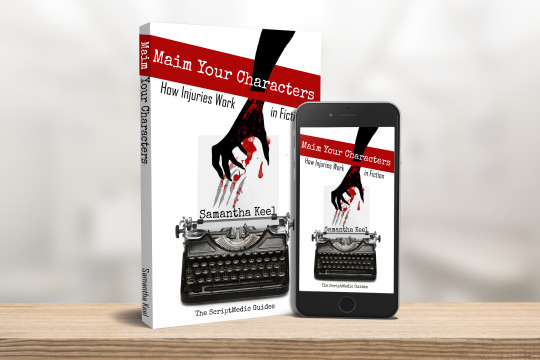
This post is an excerpt from Maim Your Characters, out TODAY from Even Keel Press. If you’d like to read a 100-page sample of the book, [click here]. If you’d like to order a print copy, it’s available [via Amazon.com], and digital copies are available from [a slew of retailers].
xoxo, Aunt Scripty

Humans! Humans!
It is Mothaflippin’ Launch Day!
Maim Your Characters isout, it is out today,and I am one excited Scripty!
The preorders went amazingly well. We sold almost $4,000 worth of business, which included –
91 signed print copies of the book, sold in 8? 9? countriesalmost 150 digital editions over 50
signed
digital editions
Holy Poops! Holy ungodly poops!!
Plus, the book is doing super well on Amazon, too, ranking as high as 80th in its category over the last few days. That is super important to the long term health of the book (and, by extension, the author!), and it’s a very promising start.
AND there is More™
Every preorder came with some Bonus Content, which included:
- An additional 3 injury analyses, not included in the book.
- Black Sails: How John Silver’s amputation made him a legend (and yet still respected the character, the injury, and the context of the era)
- Person of Interest: How Root’s impromptu surgery made her into a digital demigod
- Master and Commander: The Far Side of the World: How the movie managed to stop an out-of-control protagonist in his tracks by reminding him of what mattered
- The official ScriptMedic Injury Worksheet, a one-page guide to keeping track of not just a character’s injuries, but the hows and why of thems – and what changes because of them.
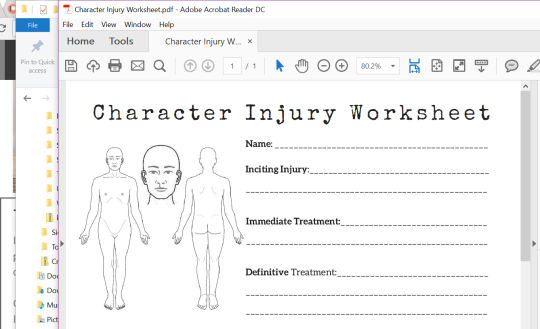
That Bonus Content is Still Available!
Pick up a copyofMaim Your Characters from any retailer between now and 9/11/2017, email me your receipt to AuntScripty {at} gmail {dot} com , and I will send you a link to the bonus content! (Redact any info you don’t want to share, I won’t be offended.)
Where Can I Get This Amazing Thing?
You mean this?
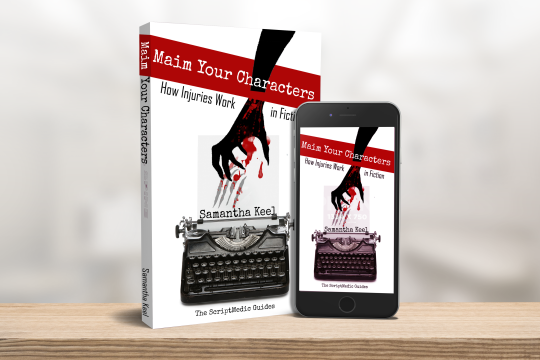
It is available at:
Thank you so much for helping make this launch crazy successful and I’m extremely grateful that you all have trusted me so much. As a first-time author, this is an overwhelmingly amazing launch, and I can’t find the words to express how awesome this has been. I’ve cried at least twice.
Thank you for being amazing, awesome readers, and for helping make things go as smoothly and as wonderfully as it has. You all mean the world to me.
xoxo, Aunt Scripty

Hey all!
By a little bit of a timing fluke, Maim Your Characters went up on sale on Amazon.com in paperback form a few days early. (It officially launches tomorrow!)
Unbeknownst to me, they put it on sale.
List price is $17.99 for the paperback, but Amazon is offering it for 15% off at $15.49 as of September 3rd, 2017.
I don’t know how long that will last, but I assume it’s a Labor Day sale thing, so [go ahead and get yours] before the price goes back up!
xoxo, Aunt Scripty
Today’s post is an excerpt from my upcoming book Maim Your Characters: How Injuries Work in Fiction. What follows is one of the nine injury analyses which appear in the book.
Those who preorder the book, or who email me their receipt for a copy purchased from any retailer between 9/4/2017 and 9/11/2017 ( AuntScripty {at} gmail {dot} com ), will receive a package of bonus materials including three additional injury analyses and the official ScriptMedic injury worksheet.
The additional analyses are: John Silver’s amputation in Black Sails, Root’s transcendence into a demigod in Person of Interest, and the injury that changes the course of Master and Commander: The Far Side of the World.
Misery, by Stephen King
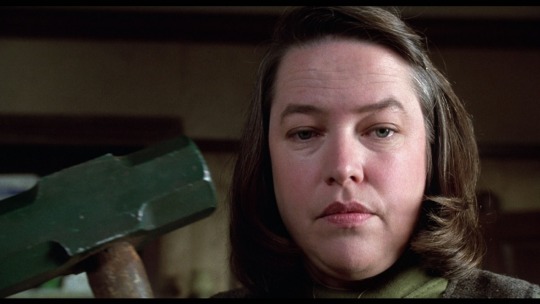
Format: Novel (Also a feature film)
Genre:Horror
Reality:Realism
We’ve been citing Misery as an example throughout this book, and now is the time to bring it all together.
TheInciting Injury happens off-page and before the opening scene of the novel. Writer Paul Sheldon finishes his latest novel, a work he hopes will take him from being a Genre Hack to a Respected Author. Having finished his book, Paul drives off to take his manuscript to his publisher… and gets caught in a blizzard. He crashes his car into a ditch and is severely injured.
Paul’s legs are both broken, and he suffers a significant concussion and probable traumatic brain injury, though there’s little evidence of this other than his lapsed memory of the first days of his recovery.
The brilliance of Stephen King is in his slow exposition of the arc. We learn this story in bits and pieces as the story goes on.
We learn later, for example, about the Immediate Treatment Annie Wilkes offered Paul when she “rescued” him from his car crash: she pulled him from his car in the middle of the blizzard, threw him on the backseat of her pickup like a gunnysack, and drove him to her house for care. (Annie is a once-upon-a-time nurse, who we later learn was barred from practicing after her patients kept dying suspiciously.)
As for her so-called Definitive Treatment for Paul Sheldon’s mangled legs… well, she splints his legs (badly), ignoring the most severe injuries (his broken hips). She also allows him time to rest, letting him sleep through the worst of the pain and the recovery.
Crucially for the addiction plot of the novel, she also force-feeds him Novril, a fictional painkiller that is supposed to be the allegory of codeine.
In fact, when we meet Paul, he is already deep in the throes of the Novril addiction, and numerous times we see his agony multiply without his medication. We see him force his way out of his room — risking his life, given that he’s held hostage — to get Novril. His addiction sets in deep, and it doesn’t let go.
The entire book’s present tense is set in the Rocky Road to Recovery, where Paul is recuperating from his injuries, and the stumbling blocks on that road to recovery are staggeringly huge. In fact, those stumbling blocks are the plot points of the novel; the injury plot and the global plot are one and the same.
For one, he’s not getting proper physical therapy, so Paul never recovers to the point of being able to walk.
For another, he’s got the nasty Novril addiction to fight.
For a third, his captor is demanding he write her a novel all her own — meaning that he must be moved to a wheelchair well before he’s ready, and endure the pain of sitting with broken hips and legs. He must endure this for hours while he fights to write a novel she won’t kill him over.
Of course, the villain adds new injuries to the mix…
Annie Wilkes amputates his left foot with an axe, in a fit of rage over something Paul’s done. (In the movie, Annie, played by the brilliant Kathy Bates, hobbles Paul with a sledgehammer.)
Later, she cuts off his thumb, again for disobedience.
(While it’s tempting to see these as separate injury events, they function more as stumbling blocks in his global injury/recovery arc; although they’re mentioned, and the psychological impacts are profound, Sheldon’s story is more about his overall disability and the pickle it puts him in than the individual pieces that go wrong.)
To make matters worse, Paul develops an infection in his kidneys toward the end of the book.
But come the Big Test, the big break where Sheldon escapes Annie’s wrath… well, that’s a trial, isn’t it? The woman has already killed a state trooper and outsmarted a half-dozen others.
Paul Sheldon has to take her down — mangled legs and all.
The image of Paul force-feeding Annie Wilkes burning pages of the manuscript she made him write is forever seared in the consciousness of anyone who reads the book (or watches the brilliant movie adaptation). Moreover, in spite of it all, Paul overcomes a formidable opponent with the tools he’s managed to wheedle from her: a typewriter, a stack of pages, a stolen can of lighter fluid, and a single match.
From an injury arc perspective? Well, in the struggle, Paul is forced to crawl on the floor. Annie grabs his still-healing stump and squeezes. He also gets glass in his arm from a broken champagne bottle.
He spends the end of the climax crawling to a closet looking for Novril, taking a small fistful before passing out. Later, when he wakes up, he’s rescued by cops coming to interview Annie Wilkes.
In the New Normal, set nine months after his experience in Annie Wilkes’ hell house, Paul has had to undergo a reinjury (the rebreaking of his legs to allow them to heal properly this time), but now he’s at least walking; King graces us with the Clack… clack… clack… of his two walking sticks.
In fact, it becomes a horror refrain, as Paul is thinking about Annie even now. In his moments of terror in the hell house, he saw Annie everywhere: behind couches and doors… (His fear is unfounded; he’s really seeing a cross-eyed Siamese named Dumpster.)
So his New Normal is, despite everything, one of only partial disability: he can walk, on crutches, with the hope for better ability through further rehabilitation.
Now, as to Sheldon’s psychology…
Sheldon is an interesting case study for recovery because he has only one person to help him, and she’s the villain of the story, plain as day. While his (partial) recovery is in her interest — he has to be healthy enough to write for her, after all — it’s certainly not in her interest to have him recover fully.
So Paul spends the book in the space between absolutely brokenandcompletely well, and will spend the rest of his life in that space — remember his amputations.
His addiction to Novril is his addiction to a few things: not only painless existence, but sleep and retreat.
The Injury Arc
Inciting Injury: Paul breaks his legs and hips in a nasty car crash.
Immediate Treatment: He’s rescued from the snowbank by his Number One Fan, Annie Wilkes.
Definitive Treatment: Annie has splinted Paul’s legs (badly), and he’s given time to recover in bed.
Rockson the Rocky Road to Recovery: Paul must contend with a painkiller addiction, an evil captor (who is also an Angel of Death), he endures two new amputations, he’s got terrible pain, UTIs, and he must write through the pain and against
the clock.
The Big Test: Paul must kill Annie Wilkes before she kills him. He succeeds!
The New Normal: Paul has Some Disability later on. (He actually lives through a medical reInjury, briefly summed up in the last chapter: his doctors have to rebreak his legs to let them set correctly.)
What Can We Learn?
First of all, let’s just say it: none of us are ever going to write a novel as absolutely brilliant as Misery. I’m pretty sure it can’t be done. King is a bona fide genius, and that’s all there is on the topic.
What can we take away? How can we write a story likeMisery?
Well…
For starters, look at how King used disability, not only by itself, but as a way to entrap his character. Annie Wilkes needs no chains to keep Paul Sheldon trapped in her house. She’s got his broken legs — and she can keep taking pieces of him any time she wants.
In fact, that’s one of the terrifying things about the story: there is alwaysanother level to sink to, whether it’s psychological or physical, always some fresh horror that can be visited upon Paul. Even when he leaves her custody he’s terrified.
But this can be seen from an opposite and empowering perspective: don’t discount the disabled hero! Paul still manages to kill Annie with what she’s given him (and what he’s stolen): a manuscript, a match, a typewriter, and some lighter fluid, in spite of all the crash and her wrath inflict upon his body. Go Paul!
Also, especially if it’s a one-off book, don’t be afraid to let your character be disabled in the end! Sheldon might be walking, but he’s walking on crutches. That’s okay — in fact, it’s perfectly appropriate.

This post is an excerpt from the forthcomingMaim Your Characters, out September 4th, 2017 from Even Keel Press. If you’d like to read a 100-page sample of the book, click here. If you’d like to preorder signed print or digital copies of the book before 9/4/2017 and get your free bonus content, or claim Executive Producer status of the upcoming Blood on the Page, click here.
xoxo, Aunt Scripty
Look what showed up at my house today!!
How do I get one?
I need one too
Hey all! Since @lih67 and @seafoxfireasked…
Three easy ways to get it:
1) Preorder through me, I have a few extra copies left! I have signed print, signed digital, and unsigned digital copies available.
2)Print via Amazon (this link actually went live a couple days early, because I Am A Doofus, but it works, so rock with it!)
3) Digital copies! The book is available via Amazon, Kobo, iTunes, Nook, … Your book ecosystem, you do you.
[Amazon]
The book officially comes out Monday, so any retailer offering on preorder will be auto-delivering on Monday.
xoxo, Aunt Scripty
Post link
The Structure of an Injury Plot

An injury plot works on one very simple three-part platform:
A character gets hurt. (The Beginning)
That character gets treatment and begins to feel better, but must navigate the world in a state of partial disability. (The Middle)
Finally, the character settles into their new normal, whether that’s back to a healthy baseline, living with some partial disability, or suffering a total disability of one body part or another. (The End)
Congratulations! This book is done. Go forth and maim your characters!
If only…
The good news is that sticking to this simple structure will give you a perfectly reasonable injury tale. Observe:
While daydreaming about smashing a homer at the company softball game, Mary trips over the ottoman, falls, and breaks her wrist. She tries icing her wrist, but the pain just keeps getting worse. (The Beginning)She goes to the ER and gets X-rays and a cast. Thoughts of the game are replaced with daily challenges: how to button her shirts, how to drive her stick shift, how to type her TPS reports at work. She solves these challenges by asking her wife for help with her shirt, swapping cars for a couple of weeks with a coworker who has an automatic, and using dictation software. (The Middle)
Eventually, Mary’s cast comes off. Her wrist still hurts when the weather changes, but mostly she can ignore it. The softball game is all but forgotten. (The End)
This progression certainly works, although it’s a little dull and, most importantly, it lacks meaning. At present, it’s a plot, but not really a story. Remember, Mary needs to change in some fundamental way for it to be a story with meaning (rather than a series of things that happen).
One way we could add some meaning is defining why the softball game is so important to her. Does she need to redeem herself for a mistake? Does she miss the glory days of her youth? Is she trying to impress her boss – or a potential side lover? (Scandal Alert! Or, a perfectly healthy polyamorous relationship.)
In short: this plot is good, or at least makes sense, but now let’s elevate this plot to the level of story.
In my experience, this is where most injury plots fall apart. There’s a very clear cause – a character is injured, usually shot – but there’s no effect on the person or on the story. It becomes simply a piece of texture, an element of “grit” that carries no weight of meaning behind it.
(If texture is something you’re interested in for your story – if you want the injury for the sake of having an injury, not as a mirror to hold up to your character – that’s okay too, as long as the injury is fairly minor. We’ll get to this in Part 8: Sweating the Small Stuff.)
So we’ve taken a look at the Beginning, Middle, andEnd of Mary’s broken wrist plot, and touched on why this might matter to her. All of which is great! But let’s break down those three components into smaller pieces that will help us understand the particular quirks of an injury plot.
There are six distinct phases of the injury portion of the injury plot.
Broken down by plot section, these are:
The Beginning
TheInciting Injury: the moment and manner in which the character gets hurt.
TheImmediate Treatment: what the character does in the moment to feel better and avoid further injury.
The Middle
TheDefinitive Treatment: when the character receives care which ultimately begins their healing process.
TheRocky Road to Recovery: when the character faces challenges relating to their new disability and how they cope with those problems during healing.
The End
TheBig Test: the moment when a character must overcome a greater challenge related to the global plot – while still recovering from their injury.
TheNew Normal: when your character’s final degree of disability becomes apparent. They can have No Disability, a Partial Disability, or be Totally Disabled (for the affected body part).
You can see places where the five fundamental elements of storytelling mesh into the injury plot. The Inciting Injury is the Inciting Incident, the Progressive Complications are in the Treatment stages and the Rocky Road to Recovery, the CrisisandClimax parallel nicely with the Big Test, and the Resolution is one and the same as the New Normal.
So why the relabeling? Because it’s easy to get distracted by vague terms. The labels that are injury-specific will help you remember the pieces you need to have in place in order to make sure your audiences find your arc believable.
Let’s take another look at Mary’s wrist fracture, through the lens of the Six Phases:
Inciting Injury: Mary trips over the ottoman and breaks her wrist.
Immediate Treatment: Mary tries to ice her wrist and hopes it gets better, but it doesn’t.
Definitive Treatment: Mary goes to the ER, gets X-rays and a cast.
The Rocky Road to Recovery: Mary’s everyday life becomes more challenging with her broken wrist! Driving a stick shift is out, she can’t even button her own shirt, and she can’t effectively type one-handed. She solves each of these problems.
Big Test: Mary doesn’t have one… yet.
New Normal: Eventually Mary’s cast comes off, and she has a very minor Partial Disability: some lingering wrist stiffness and some aching when the weather changes.
Hopefully the first three phases are pretty clear and straightforward. But I want to talk about the Rocky Road to Recovery for a little bit, because, at least at the moment, it’s the easiest way to touch on the third rail of the story: why the injury actually matters.
Why is it, exactly, that these three tasks are so important to Mary? Essentially, what parts of herself does this injury force her to face?
Buttoning Her Shirt: As it stands, this is just an inconvenience, one that will go away in a few weeks. But what if Mary is very independent, and hates anyone – even her wife – seeing her vulnerable and weak? Why would she feel this way? Maybe when she was younger, Mary had to take care of her aging grandmother, and she always hated buttoning her grandmother’s blouse. She always vowed that she would never get to that stage in her life – and yet here she is. Maybe she’s coming up on a birthday and fearing her older age.
(Note that these concepts are both very natural and very ablist. On the one hand, change is extremely hard, especially where it concerns things we take for granted, such as our ability to do anything we choose. On the other hand, the mindset that becoming disabled is an awful thing implies that the lives of disabled people are awful, which doesn’t necessarily follow. Be aware of what you’re writing as you write it!)
Swapping Cars: Again, this is an inconvenience – until we know why it’s a big deal for Mary. Is she super proud of her ability to drive a stick shift? Is she super proud of her car as a status symbol – and now she’s swapping her this-year’s Lexus for her coworker’s twelve-year-old Civic? What if she’s a neat freak, and the person she’s switching cars with is a total slob? Or, what if she just got her car – by inheritance, and she has conversations with her car as though it’s her lost parent?
In any of these cases, why does it matter?
Typing and Work: Why does it matter so much that Mary has difficulty typing? Is she on the verge of losing her job – hence her burning desire to impress at the softball game? Is it her dream job she’s at risk of losing, one she’s fought to get? Does she feel like an imposter, like she’s gotten someplace she doesn’t actually deserve, and maybe losing the job is some cosmic retribution for her masquerade? Or maybe she’s self-conscious about her voice (why? An utterly embarrassing failure at a school talent show when she was a teen?), and doesn’t want to use dictation software where other people can hear – but it’s the only way to keep doing her work?
As you can see, this is the single best place where an injury plot can teach us about Mary. With just three relatively small challenges, we learn about her grandmother’s illness, her connection with her lost parent, and her sense of being an imposter at a job she doesn’t deserve (even if she does). All of a sudden, Mary isn’t just a woman who tripped over an ottoman – she’s a person, with a story. Maybe we even feel like we know her. Maybe we identify with these pieces of her we’ve discovered through her struggle.
The magic of storytelling is that if what happens to the character matters to the character, and we know why that is, then what happens will matter to your audience as well.
In the next few sections, we’re going to break down each part of the injury plot more thoroughly, including the way some stories, great and small, have approached them. I’m also going to give you a rough sketch of a story made especially for this book that will illustrate the way each portion of the injury plot might work.

This post is an excerpt from the forthcoming Maim Your Characters, out September 4th, 2017 from Even Keel Press. If you’d like to read a 100-page sample of the book, click here. If you’d like to preorder signed print or digital copies of the book before 9/4/2017, or claim Executive Producer status of the upcoming Blood on the Page, click here.
xoxo, Samantha Keel
The Structure of an Injury Plot was originally published on ScriptMedicBlog.com

(This post is excerpted from the forthcoming Maim Your Characters.)
The Structure of an Injury Plot
An injury plot works on one very simple three-part platform:
A character gets hurt. (The Beginning)
That character gets treatment and begins to feel better, but must navigate the world in a state of partial disability. (The Middle)
And finally, the character settles into their new normal, whether that’s back to a healthy baseline, living with some partial disability, or suffering a total disability of one body part or another. (The End)
Congratulations! This book is done. Go forth and maim your characters!
If only…
The good news is that sticking to this simple structure will give you a perfectly reasonable injury tale. Observe:
While daydreaming about smashing a homer at the company softball game, Mary trips over the ottoman, falls, and breaks her wrist. She tries icing her wrist, but the pain just keeps getting worse. (The Beginning)
She goes to the ER and gets X-rays and a cast. Thoughts of the game are replaced with daily challenges: how to button her shirts, how to drive her stick shift, how to type her TPS reports at work. She solves these challenges by asking her wife for help with her shirt, swapping cars for a couple of weeks with a coworker who has an automatic, and using dictation software. (The Middle)
Eventually, Mary’s cast comes off. Her wrist still hurts when the weather changes, but mostly she can ignore it. The softball game is all but forgotten. (The End)
This progression certainly works, although it’s a little dull and, most importantly, it lacks meaning. At present, it’s a plot, but not really a story. Remember, Mary needs to change in some fundamental way for it to be a story with meaning (rather than a series of things that happen).
One way we could add some meaning is defining why the softball game is so important to her. Does she need to redeem herself for a mistake? Does she miss the glory days of her youth? Is she trying to impress her boss – or a potential side lover? (Scandal Alert! Or, a perfectly healthy polyamorous relationship….)
In short: this plot is good, or at least makes sense, but now let’s elevate this plot to the level of story.
In my experience, this is where most injury plots fall apart. There’s a very clear cause – a character is injured, usually shot – but there’s no effect on the person or on the story. It becomes simply a piece of texture, an element of “grit” that carries no weight of meaning behind it.
(If texture is something you’re interested in for your story – if you want the injury for the sake of having an injury, not as a mirror to hold up to your character – that’s okay too, as long as the injury is fairly minor. We’ll get to this in Part 8: Sweating the Small Stuff.)
So we’ve taken a look at the Beginning, Middle, andEnd of Mary’s broken wrist plot, and touched on why this might matter to her. All of which is great! But let’s break down those three components into smaller pieces that will help us understand the particular quirks of an injury plot.
There are six distinct phases of the injury portion of the injury plot.
Broken down by plot section, these are:
The Beginning
TheInciting Injury: the moment and manner in which the character gets hurt.
TheImmediate Treatment: what the character does in the moment to feel better and avoid further injury.
The Middle
TheDefinitive Treatment: when the character receives care which ultimately begins their healing process.
TheRocky Road to Recovery: when the character faces challenges relating to their new disability and how they cope with those problems during healing.
The End
TheBig Test: the moment when a character must overcome a greater challenge related to the global plot – while still recovering from their injury.
TheNew Normal: when your character’s final degree of disability becomes apparent. They can have No Disability, a Partial Disability, or be Totally Disabled (for the affected body part).
You can see places where the five fundamental elements of storytelling mesh into the injury plot. The Inciting Injury is the Inciting Incident, the Progressive Complications are in the Treatment stages and the Rocky Road to Recovery, the CrisisandClimax parallel nicely with the Big Test, and the Resolution is one and the same as the New Normal.
So why the relabeling? Because it’s easy to get distracted by vague terms. The labels that are injury-specific will help you remember the pieces you need to have in place in order to make sure your audiences find your arc believable.
Let’s take another look at Mary’s wrist fracture, through the lens of the Six Phases:
Inciting Injury: Mary trips over the ottoman and breaks her wrist.
Immediate Treatment: Mary tries to ice her wrist and hopes it gets better, but it doesn’t.
Definitive Treatment: Mary goes to the ER, gets X-rays and a cast.
The Rocky Road to Recovery: Mary’s everyday life becomes more challenging with her broken wrist! Driving a stick shift is out, she can’t even button her own shirt, and she can’t effectively type one-handed. She solves each of these problems.
Big Test: Mary doesn’t have one… yet.
New Normal: Eventually Mary’s cast comes off, and she has a very minor Partial Disability: some lingering wrist stiffness and some aching when the weather changes.
Hopefully the first three phases are pretty clear and straightforward. But I want to talk about the Rocky Road to Recovery for a little bit, because, at least at the moment, it’s the easiest way to touch on the third rail of the story: why this the injury actually matters.
Why is it, exactly, that these three tasks are so important to Mary? Essentially, what parts of herself does this injury force her to face?
Buttoning Her Shirt: As it stands, this is just an inconvenience, one that will go away in a few weeks. But what if Mary is very independent, and hates anyone – even her wife – seeing her vulnerable and weak? Why would she feel this way? Maybe when she was younger, Mary had to take care of her aging grandmother, and she always hated buttoning her grandmother’s blouse. She always vowed that she would never get to that stage in her life – and yet here she is. Maybe she’s coming up on a birthday and fearing her older age.
(Note that these concepts are both very natural and very ablist. On the one hand, change is extremely hard, especially where it concerns things we take for granted, such as our ability to do anything we choose. On the other hand, the mindset that becoming disabled is an awful thing implies that the lives of disabled people are awful, which doesn’t necessarily follow. Be aware of what you’re writing as you write it!)
Swapping Cars: Again, this is an inconvenience – until we know why it’s a big deal for Mary. Is she super proud of her ability to drive a stick shift? Is she super proud of her car as a status symbol – and now she’s swapping her this-year’s Lexus for her coworker’s twelve-year-old Civic? What if she’s a neat freak, and the person she’s switching cars with is a total slob? Or, what if she just got her car – by inheritance, and she has conversations with her car as though it’s her lost parent?
In any of these cases, why does it matter?
Typing and Work: Why does it matter so much that Mary has difficulty typing? Is she on the verge of losing her job – hence her burning desire to impress at the softball game? Is it her dream job she’s at risk of losing, one she’s fought to get? Does she feel like an imposter, like she’s gotten someplace she doesn’t actually deserve, and maybe losing the job is some cosmic retribution for her masquerade? Or maybe she’s self-conscious about her voice (why? An utterly embarrassing failure at a school talent show when she was a teen?), and doesn’t want to use dictation software where other people can hear – but it’s the only way to keep doing her work?
As you can see, this is the single best place where an injury plot can teach us about Mary. With just three relatively small challenges, we learn about her grandmother’s illness, her connection with her lost parent, and her sense of being an imposter at a job she doesn’t deserve (even if she does). All of a sudden, Mary isn’t just a woman who tripped over an ottoman – she’s a person, with a story. Maybe we even feel like we know her. Maybe we identify with these pieces of her we’ve discovered through her struggle.
The magic of storytelling is that if what happens to the character matters to the character, and we know why that is, then what happens will matter to your audience as well.
In the next few sections, we’re going to break down each part of the injury plot more thoroughly, including the way some stories, great and small, have approached them. I’m also going to give you a rough sketch of a story made especially for this book that will illustrate the way each portion of the injury plot might work.
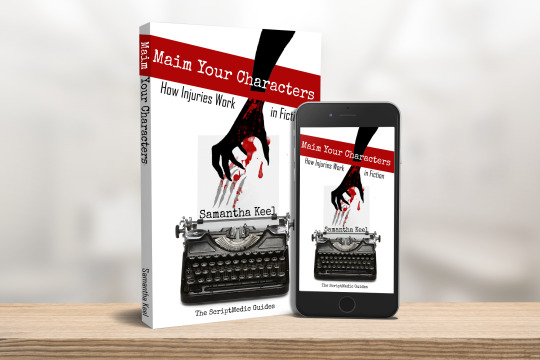
This post is an excerpt from the forthcoming Maim Your Characters, out September 4th, 2017 from Even Keel Press. If you’d like to read a 100-page sample of the book, click here. If you’d like to preorder signed print or digital copies of the book before 9/4/2017, or claim Executive Producer status of the upcoming Blood on the Page,click here.
xoxo, Aunt Scripty

(Excerpted from the forthcoming Maim Your Characters)
Before we even start to look at injury plots specifically, it’s worth taking a good strong look at what stories are overall. This definition applies not only to an injury story, but to all stories.
Ready? Here goes:
A plot is what happens – the outside events of the tale.
A story is the change a character undergoes when faced with mounting obstacles and the consequences of their own choices.
Shawn Coyne (The Story Grid) understands that there are always two tales, woven together to form a truly compelling story. There’s the External Plot, the events of the story. Then there’s the Internal Plot, the changes that the character undergoes. His chief example is the novel Silence of the Lambs, where the External Plot is a thriller – but the Internal Plot is about Clarice Starling’s disillusionment with her budding career at the FBI.
Lisa Cron (Story Genius) calls this second part the “third rail,” the part that our readers glom onto instantly, the emotional fire that gives your story oomph. This is the crux of storytelling.
In the end, we don’t care what happens.
In the end, we care how people behave and change.
Without the internal aspect of story construction, no one is going to care about your story. You can have the biggest, most epic battle in the history of storytelling. But unless we see how individual people are affected, it’s just cool words on a page – words that may dazzle us with their brilliant prose or wondrous events, but which fail to give us the emotional satisfaction we crave.
So whenever you construct a story – any part, any scene – you need to focus not on the events, but on how those events affect the characters. Ultimately the furniture can be as cool as can be, but we want to read about people (or people-like robots, aliens, sentient tacos, etc.).
Kurt Vonnegut taught that there are only six emotional arcs available in all of storytelling. Wikipedia describes a total of 36 plots available to storytellers. Yet from these simple and repetitive arcs can come the entire range of human emotion.

This post is an excerpt from the forthcoming Maim Your Characters, out September 4th, 2017 from Even Keel Press. If you’d like to read a 100-page sample of the book, click here. If you’d like to preorder signed print or digital copies of the book before 9/4/2017, or claim Executive Producer status of the upcoming Blood on the Page, click here.
xoxo, Samantha Keel
How Plot Differs from Story was originally published on ScriptMedicBlog.com

